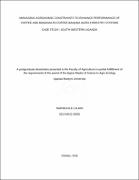| dc.description.abstract | Coffee and bananas are major cash and food crops respectively for many smallholder farmers in Uganda. These two crops can be grown as a sole crop although there is a tendency to intercrop the two. Production of both crops is declining tremendously and yields are still below their potential. This is attributed to a number of constraints of which abiotic and agronomic constraints are pertinent. However, there is no information on the effect of these agronomic constraints on yield performance of both crops. Modern science has therefore envisaged agroforestry systems as an entry point to better manage these constraints. The study aimed at determining farmers’ knowledge on the agronomic and abiotic constraints hindering coffee and banana production and their coping strategies in regard to the constraints. Furthermore, to identify the agronomic constraints in coffee-banana agroforestry systems at plant and plot level and to identify the agronomic constraints most related to coffee and banana yield loss in coffee-banana-agroforestry systems. Hence, this study purposively assessed the abiotic and agronomic constraints limiting yield of coffee and bananas in coffee-banana-agroforestry systems. The study was carried out in 9 districts of south-western Uganda taking 10 farmers per district with existing coffee-banana-agro-forestry systems. Data was collected through structured farmer interviews and use of biological assessment tools. More than 70% of farmers acknowledged importance of all constraints in limiting production. However, 96% reported on broad-leaved weeds (p=0.3153) as major agronomic constraints. These were not significantly different from those who reported on other agronomic constraints like grassy weeds and abiotic constraints like declining soil fertility, soil erosion and drought. As a way of coping with broadleaved and grassy weeds 78% and 71% of farmers respectively used hoes, 63% for declining soil fertility used organic fertilizers, 49% for soil erosion used trenches and 39% for drought used mulching. Using simple logistic regression, the knowledge on constraints and number of coping options was neither dependent on sex, age and education. Plot level management practices showed that most farms (48%) were moderately weeded, mulching was low on 43% of farms and >60% of farms had no manure, cover crops, trenches and terraces. Coffee plant level agronomic practices showed that farmers who were not de-suckering and pruning and those who had moderately desuckered and pruned their coffee was almost equal (30-40%). However, majority (70%) of them had not changed cycle of their coffee. Banana plant level management practices showed that generally farmers were practising de-suckering, deleafing and debudding (>50%) and atleast 30% were practising corm removal and propping. Most limiting factors for coffee yield were number of stems (R2=0.76), de-suckering (R2=0.99) and density of trees (R2=0.91). For bananas they were de-leafing (R2=0.89), corm removal (R2=0.89) and density of trees (R2 =0.77). All in all, farmers had knowledge of the abiotic and agronomic constraints limiting coffee and banana production in the region and how they manage them. They reported on broad-leaved and grassy weeds as agronomic constraints and soil fertility, soil erosion and drought as abiotic constraints. Most of the fields were moderately weeded as well as mulched. However, manuring, trenches, cover crops and terraces were rarely done. On the other hand, most coffee plants were moderately desuckered as well as prunned but there was no evidence of change of cycle. Also most banana plants had been desuckered, deleafed and debudded; however, corm removal and propping were practiced at a low level. Scatter plots identified desuckering, density of shade trees/shubs and number of coffee stems as agronomic constraints most related to coffee yields, whereas; corm removal, de-leafing and density of shade trees/shrubs were for bananas. Therefore, yield gap of coffee and banana caused by the agronomic constraints identified in this study should be estimated. This forms the basis for developing an effective and site-specific management strategy for these constraints in the coffee-banana agro-forestry systems of southwestern Uganda. Further studies should focus on optimizing coffee-banana agro-forestry systems to design the best-bet combinations for managing the agronomic and abiotic stresses of coffee and bananas. | en_US |


